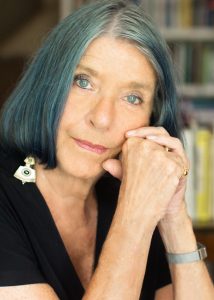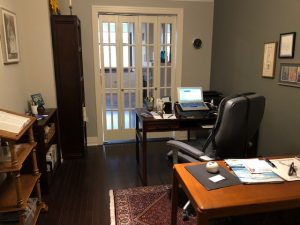 Janet Burroway is the author of plays, poems, children’s books, a memoir, and eight novels, most recently Bridge of Sand. Her book Writing Fiction (10th ed., University of Chicago Press, 2019) is the most widely used creative writing text in America. She is Robert O. Lawton Distinguished Professor Emerita at Florida State University and winner of a Lifetime Achievement Award from the Florida Humanities Council.
Janet Burroway is the author of plays, poems, children’s books, a memoir, and eight novels, most recently Bridge of Sand. Her book Writing Fiction (10th ed., University of Chicago Press, 2019) is the most widely used creative writing text in America. She is Robert O. Lawton Distinguished Professor Emerita at Florida State University and winner of a Lifetime Achievement Award from the Florida Humanities Council.
Here she talks with Shop Talk contributing editor Carol Saller.
CS: In Writing Fiction you suggest a number of questions to ask about a manuscript when revising: is there unnecessary summary, is it original, is it clear, etc. And you warn against other potential flaws: filters, linking verbs, flashback, underdeveloped characters, and so forth. As a reader, it’s difficult to focus on all those things in only one or two read-throughs, but at some point, too many readings would become problematic—especially for a novel-length work. Is there a way to economize on the number of readings? Do you have a strategy for checking all those things as you read?
JB: Alas. I do not economize on the number of readings—even for a novel. It’s true that that makes for a very long process. As you point out, I give many bits of advice, and you could end up correcting your piece to death. On the other hand, it’s also true that you learn to feel a number of things simultaneously—this filter, that lack of development, this obscurity, that sagging verb—and that many small pieces of the mosaic can be made to fit and shine, so the pattern is bodied forth.
CS: So do you revise a great deal as you write?
JB: I do. I begin my working day reading something I admire that is not remotely like what I’m writing (it helps me to break monotonous rhythms that I can fall into), then rereading whatever seems necessary to feel a “run” on today’s work. In the process, I will inevitably make corrections (I also waste a lot of paper, frequently printing out corrected text), and then begin. Tomorrow I may read all the same pages plus what I write today. If I do not want to do this, it’s a bad sign that I am boring myself or know that the story isn’t working. In that case, sometime in the future, I will probably end up scrapping it.
CS: You write, “The resistance to rewriting is, if anything, greater than the resistance to beginning in the first place” (Writing Fiction, 201). But many Shop Talk readers are copyeditors, and many copyeditors are also creative writers. So for many of us professional “revisers” the real joy in writing comes after the horrible birthing of the first draft, when we can begin to edit and reedit. What would you guess are some advantages and disadvantages that copyeditors have as creative writers?
JB: Yes, yes, absolutely. The reason that the first draft is exhausting is that you are spinning it out of nothing, in anxious uncertainty. The reason you can sit for twelve hours at revising is that it’s a joy to see how these smallest of adjustments improve flow, character, pace, surprise, clarity. I guess the reason I reread so often and so much of my own work is precisely that a good writer must be a good copyeditor. Editing the copy is what writing is.
CS: Editing and revising call for a lot of attention to detail. Francis Ford Coppola is known for identifying a one-word theme for every movie he made, which he said came in handy when making the millions of trivial decisions a director isn’t always all that interested in. He likes to give the example of The Conversation, whose theme was “privacy,” when he had to choose which kind of coat Gene Hackman should wear and he used the theme to decide on a transparent raincoat. In Writing Fiction, you mostly talk about big-picture development of a theme, some of it not entirely conscious. Do you think in terms of theme while you write as an aid to refining the details?
JB: Oh, wow. Have you got a few hours? I don’t think the theme comes first—and suspect that if it does, the work will be flat, with an upfront agenda. But if I don’t at some point recognize my theme, I don’t know what I’m doing or where I’m going, and for me the theme usually arrives as an image, some thing or event that insistently presents itself in spite of or in addition to my intentions. Another way of saying this is that the book or story knows more than I do. Part of the anxiety of the first draft is that until I know what that something is, I work in the dark.
This moment, when I understand what the story has been trying to tell me about itself, has, literally, occurred in each novel (and often in a short story), and never more dramatically than in the second. For The Dancer from the Dance I had taken the voice of a late-life diplomat in Paris. The diplomat befriends a young American girl, Prytania, and introduces her to a prominent young mime and his wife, and also to an elderly motion sculptor. Complication, danger, and heartbreak follow. I had gradually come to see that the diplomat, who believes himself benevolent, was in fact in love with Prytania. The novel had insistently developed many images of hands—of the mime, of sculpting, of personal touch, and so forth. I was more than halfway through the writing when I woke straight up at three o’clock in the morning with the revelation that the diplomat was not really in love with her; he was manipulating her. In a failing career, he is using her to prove to himself that he has influential skills. That is what all those hands were always about: the wanton use of other human beings. The Dancer from the Dance is a boring novel and I don’t advise anybody to read it. But this very dramatic revelation of the thread that held it together—and of course of theme—taught me an important lesson about how to listen to my own images to find my theme.
So yes, the theme shows me the essential idea that is latent and needs nurturing.
 CS: Do you have favorite tools for writing? Furniture, pencils, software, music?
CS: Do you have favorite tools for writing? Furniture, pencils, software, music?
JB: What you need in order to write is intensely personal, and I envy those who can write anywhere and at any time. I am finicky and selfish. Airplanes are excellent (boredom with a hint of fear; my muse knows all about this and usually obliges with an excellent distraction). But in my daily life I must have a room dedicated to writing, and I care (I’m a little ashamed to admit this) a great deal about its décor. I have favorite books, photographs, paintings, green-ink pen, paperweights. I need silence. And I absolutely must have a window. I must be able to close my door, and also to be somehow open to the world. For thirty years I had a study with a mullioned glass door onto the living room and could check on my sons without destroying either their concentration or mine, and I suppose that has dictated this particular whim. My new home in Chicago was perfect in every way except that my study had no window. I hired a contractor to cut a big mullioned glass door into the wall. Now I can look over my computer and through the dining room to two large windows, Deco buildings, and a slice of Lake Michigan.
It is not unusual that I am trying to finish a novel, or at least keep it on life support, through the move into this new home. Against all logic, at the end of every long project, I seem to feel it necessary to rip out a wall, buy a new place, install a new bathroom . . . some absolutely terrible interruption or eruption in my life. I don’t get it, really, but it may have to do with reluctance to let the piece go, or—this feels truer—a need to exercise some different kind of creativity in order to get the necessary last burst of energy.
 CS: This is your 10th edition of Writing Fiction. What parts of the book are most changed from the original 1982 edition, and what does that say about how the process of creative writing has evolved or not evolved since then?
CS: This is your 10th edition of Writing Fiction. What parts of the book are most changed from the original 1982 edition, and what does that say about how the process of creative writing has evolved or not evolved since then?
JB: Every edition changed somewhat, though basic principles remained the same. I, and then my advisors and I, tried to be receptive to the concerns of writing teachers and the changes in fiction and pedagogy. The first edition had no section on the writing process; early editions did not deal much with revision or theme. Character development, especially through dialogue, has been expanded in every new version; setting has been divided into two chapters and resutured in this one. Metaphor too has contracted and expanded as a subject over the years. The stories we chose as examples at the end of each chapter became more American and realistic, and then more multicultural and experimental. I added a section on kinds of fiction, and then on appropriation. Advice on publishing came and went, as did prompts from other disciplines. Early editions contained example short stories followed by critical questions. I eventually decided this put too much emphasis on the familiar process of lit class discussions and too little on the writer’s point of view. Early on there were recommendations of other how-to writing books, until there became too many to read and choose from. Every edition updated the examples—and it has been one of my satisfactions that, no matter how much the craft of fiction changes over the years, there are always new and exciting illustrations of principles in the text.
Janet Burroway can be found online at JanetBurroway.com and on Twitter (@janetburroway), LinkedIn, and Facebook.
Photo of Janet Burroway by Mary Stephan.
~ ~ ~

 Carol Saller’s books include The Subversive Copy Editor and the young adult novel Eddie’s War. You can find Carol online at Twitter (@SubvCopyEd) and at Writer, Editor, Helper.
Carol Saller’s books include The Subversive Copy Editor and the young adult novel Eddie’s War. You can find Carol online at Twitter (@SubvCopyEd) and at Writer, Editor, Helper.
Sign up for Carol’s email updates.
Please see our commenting policy.


